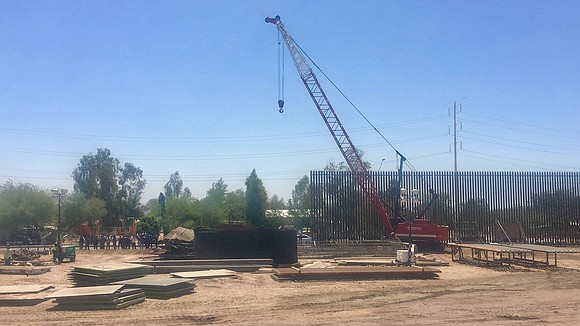Snapshots from the US-Mexico border
CNN/Stylemagazine.com Newswire | 4/30/2018, 1:42 p.m.
By Tal Kopan, CNN
(CNN) -- CNN went with Department of Homeland Security Secretary Kirstjen Nielsen as she traveled to the US-Mexico border on Wednesday.
Amid a pitched battle in Congress over funding for President Donald Trump's long-promised border wall and a National Guard deployment to what the secretary calls a "crisis" at the Southern border, the trip took DHS and CNN directly to ground zero in the debate.
Nielsen visited the construction site of replacement fencing in Calexico, California, and the existing fencing system at the San Luis Port of Entry in Yuma County, Arizona, taking a helicopter ride in between that followed existing border structures along the way.
Here are some scenes from the trip.
Calexico, California
Thirty-foot steel bollard fencing goes up in Calexico, California. The replacement project was authorized in 2017 government funding by Congress, and it takes the place of fencing that pales in comparison with the new structure.
Construction began in late February and will cover 2.25 miles of the border.
Congress has been more inclined to authorize replacement projects and existing fence designs than anything that can be construed as Trump's "wall." Nevertheless, the administration has touted this project as new wall.
"The 30-foot-high bollard-style wall is a massive upgrade, and exactly what the men and women of the Border Patrol have requested. It's not mere replacement, for dilapidated, ineffective low wall and vehicle barriers: It's a new wall and part of a wall system," Nielsen said later in the day.
Nielsen's visit to the construction was brief and interrupted by protesters. Taking advantage of the gap in the fence left by the construction, demonstrators on the Mexican side of the border approached and stood in the opening, holding bright yellow signs and chanting in Spanish. One large sign read, "Trump no al muro," which translates to "Trump no to the wall."
Shortly after the protesters arrived, the secretary and her staff departed for their next stop.
US-Mexico border
Along the helicopter ride, multiple kinds of border fencing were visible along the US-Mexico border in California and in Arizona. In a stretch of desert with sand dunes, DHS has constructed a "floating fence," which sits on top of the sand and can shift with the wind and changes in the dunes to block illegal border crossings.
In other stretches, traditional steel fencing or low vehicle barriers were used.
Yuma, Arizona
Close to Yuma, Arizona, and the San Luis Port of Entry, the fencing system consists of multiple barriers. With the Mexican side of the border heavily developed, the multiple fences create a stretch of land in the middle where surveillance cameras and agents can spot illegal activity more clearly and have more time to intercept people.
The Mexican side of the border is pictured at the top of the frame, and Arizona on the bottom.
No man's land
The no man's land between the fences stretches for miles. On the Mexican side, to the right of the image, is fencing made of repurposed Vietnam-era helicopter landing mat material, topped with wire in some places. On the US side, to the left of the image, taller see-through fencing blocks the way, with an additional lower metal fence topped with barbed wire on the other side.
The sand in the middle is smoothed by agents dragging tires behind their vehicles, in part so they can spot any disturbances in it from footprints or traffic.
At this stretch of the border, agents say, the vast majority of crossings they see are by migrants who stop once they reach the center of the fencing system, waiting for agents to find them so they can pursue claims of asylum protections in the US.
Much of what the agents do can involve emergency medical care. In some places, smugglers have built roads, ramps and other infrastructure on the Mexican side to allow people to easily get over the first fence, after which they can drop upward of 10 to 15 feet onto the US side, breaking bones or hurting themselves on the wire.
Standing between the fences, Nielsen held a press availability with Republican Arizona Gov. Doug Ducey. Afterward, she greeted and thanked the local officials and deployed National Guardsmen who had stood behind them for the event.




